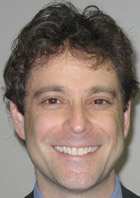Anesthesiology researchers at Washington University School of Medicine in St. Louis have found that a device to ensure that surgery patients have no memories of their operations may not lower risk of the phenomenon known as anesthesia awareness.

“Anesthesia awareness implies that a person was able to form memories while under anesthesia,” says principal investigator Michael S. Avidan, M.B., B.Ch., associate professor of anesthesiology and surgery. “It’s extremely rare, only occurring in about one to two surgical patients per thousand, but because of the huge number of operations performed annually, the total number of people with awareness during anesthesia is significant. It can be distressing and can contribute to long-term, psychological consequences such as anxiety and even post-traumatic stress disorder in some cases.”
Reporting in the March 13 issue of the New England Journal of Medicine, a team led by Avidan compared outcomes in almost 2,000 surgery patients who were treated at Barnes-Jewish Hospital in St. Louis. Half were monitored with a device that measures bispectral index (BIS). The BIS measurement takes data from an electroencephalogram that monitors brain waves. When a person is fully awake, their BIS measurement is 100. No brain wave activity would be rated as zero. Anesthesiologists who use BIS monitors are advised to adjust patients’ anesthesia in order to keep the reading between 40 and 60 to prevent anesthesia awareness during surgery.
Investigators used end-tidal anesthetic gas (ETAG) to guide anesthesia administration in the rest of the study patients. Unlike BIS monitors that measure brain waves, ETAG monitoring measures the amounts of anesthetic gases present in the air that a patient exhales. When levels get too low, the anesthesiologist may increase the levels of gas anesthetics used to keep a patient unconscious and unable to remember their experience in surgery.
A 2004 study called B-Aware had reported that using a BIS monitor could reduce the risk of anesthesia awareness, but Alex S. Evers, M.D., a co-investigator on the current study says there were some potential flaws with that initial study. First, it had not compared BIS to any other known monitoring protocols that had been used to reduce anesthesia awareness. So the team conducted what they called the B-Unaware trial.

“The first study was like having a control group that got no treatment,” says Evers, the Henry E. Mallinckrodt Professor and head of the Department of Anesthesiology. “We thought it made more sense to compare bispectral index to ETAG monitoring to see if we could detect any differences in the incidence of awareness between the two groups.”
They also wanted to see whether a BIS monitor could have detected anesthesia awareness when it occurred in the ETAG-guided group. So the brain waves of surgical patients in the latter group also were measured with a BIS monitor, but the anesthesiologist in the operating room did not see the BIS measurement during the surgery.
Although anesthesia awareness may occur in about 1 percent of patients at high risk, in this study, only two patients from each study group had memories of their surgical experience, about 0.2 percent of the total. In those cases when a patient monitored with the ETAG technique experienced memories, investigators went back and found that the BIS monitor showed that those patients were being maintained in the range that is supposed to prevent anesthesia awareness.
“Part of the risk of awareness involves the surgical procedure and individual patients,” Avidan says. “Bigger operations are more likely to produce awareness, so a person having open heart surgery will be at greater risk than one having cartilage removed from a knee. In addition, patients who are sicker at the time of surgery, and those who take certain drugs or drink alcohol are more likely to have awareness.”
But even those at elevated risk still will experience anesthesia awareness only about 1 percent of the time. For those without an elevated risk, the incidence is closer to one to two in 1,000. The researchers warn that because the risk is so low and because there were only about 2,000 patients in this study, it might not be possible to detect tiny differences between the BIS and ETAG monitoring techniques. They plan to continue comparing the techniques in larger groups of patients.
Another potential problem they note is that they used anesthetic gases, whereas the BIS algorithm was developed using predominantly intravenous anesthesia. But Avidan and Evers believe that since the vast majority of surgical anesthesia involves anesthetic gases, their study provides a truer measurement of the effectiveness of BIS and ETAG guidance in preventing anesthesia awareness.
“There was essentially no difference,” Avidan says. “We were able to achieve a very low incidence of anesthesia awareness with both protocols. But neither was able to eliminate the problem completely, and we worry that use of the bispectral index could give anesthesiologists a false sense of security that if they keep the measurement between 40 and 60, they’ll prevent anesthesia awareness. This study has demonstrated that’s not entirely true.”
Avidan says because this study showed it to be no better that other techniques, the current widespread use of BIS monitoring in operating rooms around the country may not be warranted. But he says that larger, follow-up studies need to be done to replicate or refute these findings.
Avidan MS, et al. Anesthesia awareness and the bispectral index. New England Journal of Medicine, vol 358(11), pp. 1097-1108, March 13, 2008.
This study was supported by a grant from the Barnes-Jewish Hospital Foundation.
Washington University School of Medicine’s 2,100 employed and volunteer faculty physicians also are the medical staff of Barnes-Jewish and St. Louis Children’s Hospitals. The School of Medicine is one of the leading medical research, teaching, and patient care institutions in the nation, currently ranked fourth in the nation by U.S. News & World Report. Through its affiliations with Barnes-Jewish and St. Louis Children’s Hospitals, the School of Medicine is linked to BJC HealthCare.